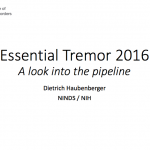 For the past two years. HopeNET has not actively solicited donations. We have been able to do so because we are an all volunteer non-profit.
For the past two years. HopeNET has not actively solicited donations. We have been able to do so because we are an all volunteer non-profit.
However circumstances have changed due primarily to two projects:
* A formal study of Essential Tremor and balance and gait. There has been very little research on this issue even though it is a critical issue facing many who have ET. The study is tentatively scheduled to begin this fall. It will be conducted by Janice Sallitt, PT, DPT, NCS. She specializes in Orthopedic & Neuro PT. The study will center on HopeNET’s Columbia, Maryland ET support group.
* In an attempt to increase awareness of Essential Tremor, Mary Cae Asay is going to produce a play about Katherine Hepburn. Because of Mary Cae’s ET, she can make her voice sound identical to Hepburn’s.
More details will follow. These are very exciting times for HopeNET. Please continue to follow our Facebook and Blog as HopeNET continues to take active steps aimed at improving the lives of those with Essential Tremor.
Your donation will be greatly appreciated.
Peter

 When we founded HopeNET 5 years ago, we felt that the thing that the ET community needed most at that time was HOPE – hence the name. In the meantime, we have strived hard to bring some hope to all with ET. Accordingly, HopeNET played a key role in having the ET conference at NIH in May 2015. Since that conference, there has been a big increase on the part of industry in developing new treatments for ET. Dr. Dietrich Haubenberger of NIH is probably in the best position to know what is going on with ET. He came to the Falls Church, Virginia ET support group on October 14th and made the attached presentation,
When we founded HopeNET 5 years ago, we felt that the thing that the ET community needed most at that time was HOPE – hence the name. In the meantime, we have strived hard to bring some hope to all with ET. Accordingly, HopeNET played a key role in having the ET conference at NIH in May 2015. Since that conference, there has been a big increase on the part of industry in developing new treatments for ET. Dr. Dietrich Haubenberger of NIH is probably in the best position to know what is going on with ET. He came to the Falls Church, Virginia ET support group on October 14th and made the attached presentation, 
 Dr. Elan Louis and colleagues at Yale University along with Dr. Lorraine Clark at Columbia University have teamed together for an important research “FASET II”, to try to identify the genes that are responsible for ET. They are calling on the assistance of the ET community to help them complete this groundbreaking research, which at the moment is the largest NIH-funded project of its kind. The help of the ET community is vital.
Dr. Elan Louis and colleagues at Yale University along with Dr. Lorraine Clark at Columbia University have teamed together for an important research “FASET II”, to try to identify the genes that are responsible for ET. They are calling on the assistance of the ET community to help them complete this groundbreaking research, which at the moment is the largest NIH-funded project of its kind. The help of the ET community is vital.